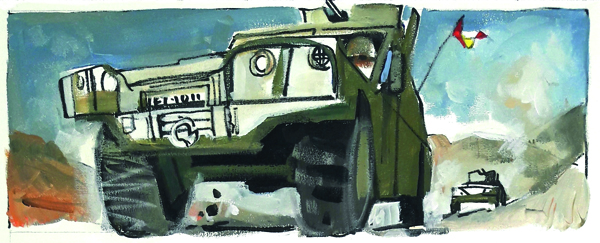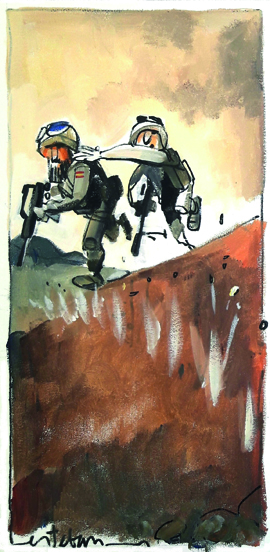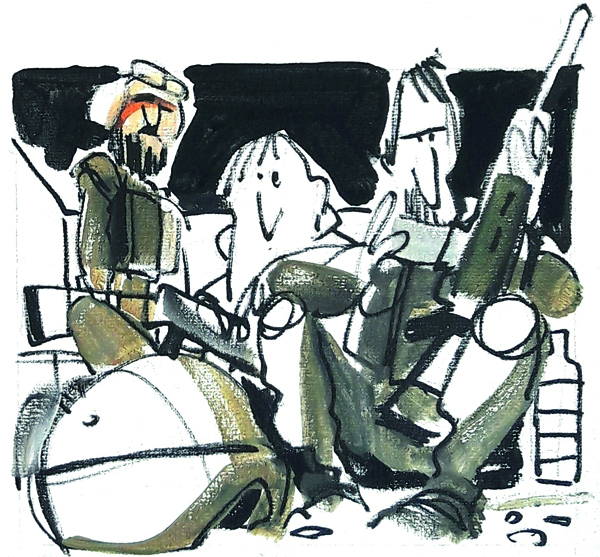- Home
- Staff
- Texto no traducido
- El Paso de Sabzak (II)
Sabzak Pass (II)
Captain Iván San Miguel
49th Infantry Regiment ‘Tenerife’
The morning of 2 September 2009 starts shrouded in calm in the vicinity of the Hamam mines. It is well known that Sabzak Pass that connects Badghis (in the north) and Herat (in the south) is a crucial logistical route between these two provinces...
In view of the increasing number of attacks in Sabzak, it was decided to carry out an operation that could provide safety and calm to its inhabitants. This mission was assigned to the Tactical Group in Support of the Elections/Grupo Táctico Español de Apoyo a las Elecciones (GTAPOEL). Two companies take 4-6 hour turns for the execution of this mission—one from the 50th Infantry Regiment ‘Tenerife’ and other from the 49th ‘Tenerife’.
With the colours painted by fate and the dice being rolled on the future, the morning of 2 September 2009, the company from the 49th Infantry Regiment ‘Tenerife’, more concretely from its Battalion ‘Albuera’, receives notice of settling in the area.
They smell the dust—a smell that will now remain recognisable for their senses forever. They see the smoke—always present in places trapped by violence— making grey blots in the landscape. The mountains surround them in a feeling of height and danger that will pursue them for the next two days.
Captain San Miguel is in control of Company ‘Albuera’. With its wide deployment, it has the mission of controlling both the hill of Sabzak Pass and the mines area, located 4 kilometres east.
Heavy fire from gunfire and missiles soon starts, initially in the south, over the 1st Section and the Command Post, and then spreads to the Weapons Section. Movement and fire break straightaway.
The First Section manoeuvres trying to neutralise the origin of the fire. Meanwhile, the Weapons Section is told to occupy positions to support the section in the worst position that has already been declared as TIC (Troops in Contact). Nobody is oblivious to the sensations that surround a soldier when contact with the enemy is declared. Then, all the previous training becomes brief. All of a sudden, tension brings to mind all the theory and practice exercised in manoeuvres for so long, that now comes to light as a sum of instinctive reactions.

After about two hours and a half combatting, the First Section takes advantageous positions and the enemy leaves the area. Likewise, the surroundings are examined in order to find a viable path between north and south.
The radio waves are filled with nicknames, those that—when broadcast—provide the confidence of always having somebody nearby, and guarantee joint action: 5V, 1A, EA, Arandela, Kent, Tánatos, Animal, Kiriki, Sparring, Barni, Ompare, Apache, Pony, Gato, Reyes, Pumu, Pumba, Dragon…
A good soldier
Then, in the stir of the combat, the precision shooter, nicknamed Sparring, and 5V, climb up a hill searching for better visibility. From a higher position, they aim at controlling the movement and fire that are taking place. Shortly before reaching the top, Sparring, with the innate intuition only good soldiers have, leaps on 5V, preventing him from being caught by the burst of a machine gun. The captain knows that, when in combat, it is always safe to have someone like Sparring nearby.

Meanwhile, in the north, the Weapons Section maintains its position in order to fix the enemy, as they wait for the other sections to come from the south to support them. In the clamour of battle, 5V receives the news that Apache has been hurt. He immediately gets in touch with the command post for his evacuation, as the battle continues. 5V feels relieved when he sees Apache climbing aboard the medical evacuation helicopter, smoking and smiling as he bleeds. Nobody in the company has failed. Nobody has forgotten—despite the circumstances of the combat—any of the orders that were given first thing and that can still be heard on every radio.
Night falls, and they gather at the ‘Málaga’ patrol base. There they heal their wounds—there are so many of them—and they start to get ready for the new actions that the wind will bring when the next day comes. Their vehicles are also damaged, and Arandela’s mechanics work a night miracle—since the night can either be an enemy or an ally depending on the soldier’s soul—managing to restore some of them, which had been seriously harmed. At night time, a fully new planning becomes necessary. They are completely exhausted.
In the early hours of the morning, with more ammunition and spare parts—since not even logistics can have a rest—Dragon comes, together with the rest of the section which was in Qala-I-Naw. The night passes calm, although they feel that the enemy is very close to them somehow—it is brought by the cool night air and the little piece of moon that can still be seen. Equally close to them is the day light of 3 September. Those who had the chance to sleep—while their partners were keeping guard confronting sounds and night—begin to wake up.
The captain decides to divide the company in two groups—A and B. Group A will go in the vanguard, together with the rest of the two sections and the Command Post of the company, including 5V, 1A, EA, Ambulance and Arandela. Group B and the rest of the company will go behind them, at a distance of 1500 metres.
Due to several mechanical problems, the vehicles must delay their departure. However, they finally start moving, in a ‘calm but tense’ environment where the absence of civilians in the area makes them foretell imminent danger. When nothing can be seen, something is hidden.
EA soon spots an armed ‘rider’, as if several centuries were mixed in the same space, at about 3.5 kilometres, on a military crest to the east of their vanguard. They continue moving with utmost care, aware of the proximity of the enemy and knowing that they did not spare fire or violence on them the previous day.
So, when they cross the last dividing line, they receive fire again, first from the north area, then from the east, and finally, from the south. However, Company ‘Albuera’ has a mission and they will fight until it is achieved, responding with more fire.
Ammunition consumption starts to be high, and in view of the steep ground and the enemy’s persistence, 5V decides to attack their positions in order to dislodge them. They are about to cross several red lines, both mentally and physically—that particular Rubicon every soldier willing to be victorious must face. Nevertheless, the strength and determination of the members of the company—that can be seen in their faces—and their permanent attitude makes the weight of decisions lighter. They are the most valuable members of the unit and also the best mental and physical fighting force one could have. ‘If the soldiers who come with me cannot do it, no one can’— Captain San Miguel claims—. ‘They are capable of anything.’ They deploy, remaining firm in their decision, confronting the fire from the enemy, as they keep shooting. They find it very hard to identify the origin of the fire, as they are stuck to the ground, wrapped up in blankets covered with sand. They occupy excellent positions, however, they must be dislodged.

They fix the north area with fire. Bullets keep whistling everywhere. The first RPGs fall—one very close to V5’s vehicle. Pumba, soldier Jorge—the shooter—hears it coming and bends down just in time, saying: ‘Here it comes, here it comes!’ Immediately, he takes his heavy machine gun again to counter the enemy with all his might.
1A and Barni quickly locate at both sides of the vehicle that Cristo drives with the expertise and composture provided by his seniority and many hours of driving. Pumu—from 1A’s VAMTAC vehicle—manipulates his primary weapon with skill and precision, and little by little, they manage to advance, taking positions to the east of the pass. ‘Come on, let’s keep supporting the fire area!’ Pony and Gato are there. All the vehicles in the A group move very slowly, shooting at the enemy positions. Shooters of the primary weapon are the main protagonists of the day—both them, and the hearts that guide them.
Fixing the enemy
At this point, 5V declares the are as TIC and orders group B to move south as much as they can, whereas group A fixes the enemy from the north and east areas.
Kent—followed by Tánatos— moves with energy along heavy fire that comes from hidden and prepared positions. Bullets whistle everywhere. Kiriki, Animal, Ompare, Dragón, Pelayo… they all act coordinated, as a single combat element. They move further and further, until they eventually reach positions in the south.

Those who have landed—since there is no assault without landing— hear their enemies’ voices and stick to the ground, shooting only what is necessary to dislodge them with their positions. The insurgents can also hear them, and they know they will soon be close to them. This morning they have discovered that these soldiers do not take fighting as a joke.
The primary weapons of the vehicles support those who have landed on a sustained basis, despite receiving precise and concentrated enemy fire. The shooters from the vehicles are crucial today. Some of their ballistic shields have even suffered four impacts. These centimetres separate the holes from their hearts—the ones that really hold the weapons and shoot tirelessly to silence the enemy, who is increasingly shier.
Spanish soldiers acknowledge the expertise and commendable courage of their enemy. However, it finally gives up before the determined drive of the First Company of Battalion ‘Albuera’. They are defeated, leaving ‘Albuera’ as the owner of the battlefield, having conquered the heights above them, even before the arrival of the aerial means. They are exhausted, and know that the combat will still last for a few hours, almost until sunset. Now they take the initiative, and the enemy is combatting from positions which are hard to defend.
ARMY UNITS
- Araba Álava |
- Albacete |
- Alicante |
- Almería |
- Asturias |
- Ávila |
- Badajoz |
- Barcelona |
- Burgos |
- Cáceres |
- Cádiz |
- Cantabria |
- Castellón |
- Ceuta |
- Ciudad Real |
- Córdoba |
- A Coruña |
- Cuenca |
- Girona |
- Granada |
- Guadalajara |
- Gipuzkoa |
- Huelva |
- Huesca |
- Islas Baleares |
- Jaén |
- León |
- Lleida |
- Lugo |
- Madrid |
- Málaga |
- Melilla |
- Murcia |
- Navarra |
- Ourense |
- Palencia |
- Las Palmas |
- Pontevedra |
- La Rioja |
- Salamanca |
- Segovia |
- Sevilla |
- Soria |
- Tarragona |
- Santa Cruz de Tenerife |
- Teruel |
- Toledo |
- Valencia |
- Valladolid |
- Bizkaia |
- Zamora |
- Zaragoza



